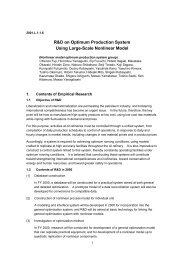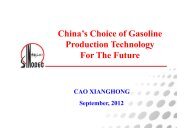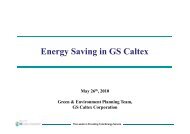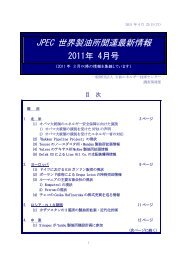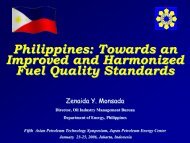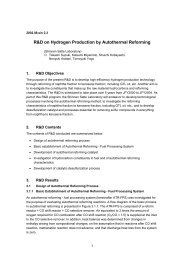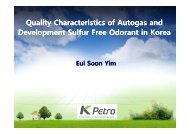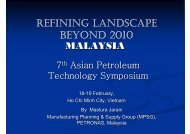R&D on Catalyst for Catalytic Cracking of Heavy Oil With High Metal ...
R&D on Catalyst for Catalytic Cracking of Heavy Oil With High Metal ...
R&D on Catalyst for Catalytic Cracking of Heavy Oil With High Metal ...
Create successful ePaper yourself
Turn your PDF publications into a flip-book with our unique Google optimized e-Paper software.
2000.M2.1.3<br />
R&D <strong>on</strong> <strong>Catalyst</strong> <strong>for</strong> <strong>Catalytic</strong> <strong>Cracking</strong> <strong>of</strong> <strong>Heavy</strong> <strong>Oil</strong> <strong>With</strong> <strong>High</strong><br />
<strong>Metal</strong> and <strong>High</strong> Residual Carb<strong>on</strong> C<strong>on</strong>tent<br />
(<strong>High</strong> residual carb<strong>on</strong> catalytic cracking group)<br />
Sodegaura No. 404 laboratory<br />
Toshio Ito, Motoo Tanaka, Tomoyuki Sumiyoshi, Yoshifumi Hiramatsu<br />
1. C<strong>on</strong>tents <strong>of</strong> Empirical Research<br />
Special petroleum laws have been repealed; competiti<strong>on</strong> with overseas petroleum companies<br />
has become fierce, and in order to beat the competiti<strong>on</strong> in the petroleum industry, stepped-up<br />
efficiency at refineries and development <strong>of</strong> new technologies have become urgent necessities.<br />
Greater efficiency and new technologies are also required at RFCC facilities. Attenti<strong>on</strong> is now<br />
being focused <strong>on</strong> treatment <strong>of</strong> coarse feedstock (low-priced feedstock which could not be<br />
treated up to the present) c<strong>on</strong>taining large amounts <strong>of</strong> residual carb<strong>on</strong> believed to be metals<br />
and coke precursors, and <strong>on</strong> treatment <strong>of</strong> RFCC feedstock in which metals, residual carb<strong>on</strong> and<br />
sulfur have increased in the course <strong>of</strong> c<strong>on</strong>tinuous treatment over two years with direct<br />
desulfurizati<strong>on</strong> units.<br />
When useful FCC gasoline and LCO are obtained from this coarse RFCC feedstock, the<br />
ec<strong>on</strong>omy <strong>of</strong> RFCC equipment improves, the range <strong>of</strong> crude oil selecti<strong>on</strong> at refineries expands,<br />
and internati<strong>on</strong>al competitiveness is strengthened. It is suspected that in the future, crude oil<br />
will be heavy and large quantities <strong>of</strong> coke will be produced, but in obtaining FCC gasoline and<br />
LCO, the volume <strong>of</strong> CO 2 discharged from RFCC equipment regenerator tower can be drastically<br />
reduced by using catalyst that produces little coke. This approach would also c<strong>on</strong>tribute to the<br />
preventi<strong>on</strong> <strong>of</strong> global warming.<br />
In light <strong>of</strong> these c<strong>on</strong>diti<strong>on</strong>s, the objective <strong>of</strong> the present research is to develop an RFCC catalyst<br />
which exhibits the following per<strong>for</strong>mance in the RFCC process when desulfurized heavy oil has<br />
been passed through, and it is assumed that this oil is a mixture <strong>of</strong> Arabian heavy and Rutawi<br />
c<strong>on</strong>taining 15ppm or more <strong>of</strong> metal and 5wt% or more <strong>of</strong> residual carb<strong>on</strong>.<br />
• FCC gasoline + LCO 64wt% or more<br />
• Coke 8wt% or below<br />
Other objectives include greater operati<strong>on</strong>al efficiency in the RFCC process, reduced volumes<br />
<strong>of</strong> CO 2 generati<strong>on</strong>, and countermeasures against global warming.<br />
1.1 Search <strong>for</strong> and improvement <strong>of</strong> highly active catalysts<br />
<strong>With</strong> RFCC catalyst, feedstock c<strong>on</strong>taining heavy fracti<strong>on</strong> and large quantities <strong>of</strong> sulfur and<br />
metals such as V or Ni must be processed so that the yield <strong>of</strong> FCC gasoline and LCO is 64wt%<br />
or more and the coke yield is 8wt% or less. For this purpose, studies have been d<strong>on</strong>e <strong>on</strong><br />
globular alumina, which is believed to generate little coke, to be used as a substitute <strong>for</strong> the<br />
c<strong>on</strong>venti<strong>on</strong>al needle alumina, and catalyst comprised <strong>of</strong> globular alumina combined with<br />
substances <strong>of</strong> different properties and ingredients have been trial-produced and examined.<br />
1
1.1.1 Evaluati<strong>on</strong> <strong>of</strong> catalyst in which the volumes <strong>of</strong> globular alumina and zeolite were<br />
increased<br />
<strong>With</strong> the aim <strong>of</strong> improving catalytic reactivity, catalyst was fabricated in which the volumes <strong>of</strong><br />
both globular alumina and zeolite were increased, and catalyst reacti<strong>on</strong>s were evaluated.<br />
1.1.2 Evaluati<strong>on</strong> <strong>of</strong> the activity <strong>of</strong> catalyst in which globular alumina are combined with<br />
regular alumina<br />
To improve catalytic reactivity even further, catalyst was fabricated in which globular alumina<br />
was combined with regular alumina, and catalyst reacti<strong>on</strong>s were evaluated.<br />
1.1.3 Impact <strong>of</strong> zeolite additive<br />
<strong>With</strong> the aim <strong>of</strong> increasing the yield <strong>of</strong> FCC gasoline and LCO even further, the volume <strong>of</strong><br />
zeolite additive added to catalyst was increased over the c<strong>on</strong>venti<strong>on</strong>al amounts, and catalyst<br />
reacti<strong>on</strong>s were evaluated.<br />
1.2 Investigati<strong>on</strong> <strong>of</strong> the factors affecting catalyst activity<br />
<strong>With</strong> the aim <strong>of</strong> attaining high yields <strong>of</strong> FCC gasoline and LCO, the relati<strong>on</strong>ships between<br />
catalyst pore distributi<strong>on</strong>, acid volume and catalytic activity were investigated. The<br />
relati<strong>on</strong>ships between catalyst OH base, distributi<strong>on</strong> <strong>of</strong> alumina in catalyst, and reacti<strong>on</strong> results<br />
were also investigated.<br />
1.2.1 Investigati<strong>on</strong> <strong>of</strong> catalytic pore distributi<strong>on</strong><br />
In examining catalyst structure, the inter-relati<strong>on</strong>ships am<strong>on</strong>g the following were studied:<br />
meso-pore (intermediate pore) positi<strong>on</strong>s, catalytic meso-pore and macro pore distributi<strong>on</strong>s,<br />
which are believed to be effective in FCC gasoline and LCO producti<strong>on</strong>, pore capacity and<br />
reactivity.<br />
1.2.2 Investigati<strong>on</strong> <strong>of</strong> catalyst acid volume<br />
Am<strong>on</strong>g catalysts yielding outstanding reacti<strong>on</strong> results, the relati<strong>on</strong>ship between acid volume and<br />
reacti<strong>on</strong> results was investigated.<br />
1.2.3 Investigati<strong>on</strong> <strong>of</strong> catalyst OH base<br />
The relati<strong>on</strong>ships between catalyst reacti<strong>on</strong> results and OH base strength, which is related to<br />
catalyst acid strength, were investigated.<br />
1.3 Examinati<strong>on</strong> <strong>of</strong> catalyst industrial producti<strong>on</strong> methods<br />
Industrial producti<strong>on</strong> methods were investigated in order to establish a method <strong>for</strong> producti<strong>on</strong>,<br />
<strong>on</strong> industrial scale, <strong>of</strong> catalyst developed <strong>on</strong> the laboratory scale. In the investigati<strong>on</strong> <strong>of</strong><br />
industrial producti<strong>on</strong> methods, attenti<strong>on</strong> was focused <strong>on</strong> catalyst compositi<strong>on</strong> and <strong>on</strong> uni<strong>for</strong>mity<br />
in catalyst structure during producti<strong>on</strong> testing and <strong>on</strong> stability during catalyst spray drying.<br />
Stability during the catalyst washing process was also c<strong>on</strong>sidered.<br />
1.4 Determinati<strong>on</strong> <strong>of</strong> catalyst practical per<strong>for</strong>mance<br />
<strong>Metal</strong> resistance, hydrothermal resistance and wear resistance <strong>of</strong> manufactured and tested<br />
catalyst were investigated in c<strong>on</strong>siderati<strong>on</strong> <strong>of</strong> use <strong>of</strong> the catalyst in practical equipment.<br />
2
2. Results <strong>of</strong> empirical research and analysis there<strong>of</strong><br />
2.1 Search <strong>for</strong> and improvement <strong>of</strong> highly active catalyst<br />
2.1.1 valuati<strong>on</strong> <strong>of</strong> catalyst in which the volumes <strong>of</strong> globular alumina and zeolite were<br />
increased<br />
In commercial catalyst , as shown in Figure 2.1-1, because there are few meso-pores, primary<br />
cracked oil produced by cracking <strong>of</strong> heavy feedstock stagnates in the pores and coke is<br />
generated. C<strong>on</strong>sequently, in order to curtail coke <strong>for</strong>mati<strong>on</strong> and have FCC gasoline + LCO<br />
produced, in the catalyst targeted <strong>for</strong> development, also shown in the Figure, it is important to<br />
increase meso-pores <strong>of</strong> uni<strong>for</strong>m size so that primary cracked oil, which can be produced by<br />
cracking feedstock, can be quickly cracked into gasoline and LCO without stagnating in the<br />
pores. As shown in Figure 2.1-2, these meso-pores produce uni<strong>for</strong>m grains. This producti<strong>on</strong><br />
can take place because when grains agglutinate, cavities which can produce uni<strong>for</strong>m grains<br />
also become uni<strong>for</strong>m.<br />
Coke<br />
Commercial catalyst<br />
Macropore<br />
Development target catalyst<br />
Macropore<br />
Meso-pore<br />
Meso-pore<br />
Primary cracked oil<br />
Gasoline<br />
Figure 2.1-1<br />
Feedstock<br />
Primary cracked oil<br />
Gasoline<br />
Feedstock<br />
LCO<br />
Comparative outline <strong>of</strong> pore structure <strong>of</strong> development<br />
target catalyst and commercial catalyst<br />
<br />
Commercial catalyst<br />
Development target catalyst<br />
Silica<br />
<br />
Needle lumina<br />
Silica · Alumina Globular alumina<br />
Meso-pore<br />
Meso-pore<br />
<br />
N<strong>on</strong>-uni<strong>for</strong>m<br />
pores<br />
Figure 2.1-2<br />
Development<br />
target <strong>Catalyst</strong><br />
Meso-pore<br />
Uni<strong>for</strong>m pore<br />
Outline <strong>of</strong> preparati<strong>on</strong> <strong>of</strong> alumina having uni<strong>for</strong>m<br />
meso-pores<br />
<br />
For this reas<strong>on</strong>, catalyst manufacture takes place in which globular alumina c<strong>on</strong>taining uni<strong>for</strong>m<br />
grain size is used. Using I4-05 catalyst, developed in 1998, as a reference <strong>for</strong> comparis<strong>on</strong>,<br />
percentages <strong>of</strong> increases in globular alumina and zeolite are presented in Table 2.1-1.<br />
3
Table 2.1-1 Volumes <strong>of</strong> added globular alumina and zeolite<br />
Item/ <strong>Catalyst</strong> I4-05 I4-10 I4-11 I4-12<br />
Globular alumina (wt%) Standard +10 +7 +9<br />
Zeolite (wt%) Standard +3 +5 +6<br />
The activity <strong>of</strong> the newly prepared catalyst was evaluated by means <strong>of</strong> the microactivity test<br />
(MAT). Prior to activity evaluati<strong>on</strong>, vanadium and nickel were added to the catalyst, and it was<br />
subjected to steaming and to pseudo-equilibrium treatment. The properties <strong>of</strong> the feedstock<br />
used in activity evaluati<strong>on</strong> are given in Table 2.1-2. The feedstock used satisfies the property<br />
requirements ultimately targeted.<br />
Table 2.1-2 Properties <strong>of</strong> feedstock used in evaluati<strong>on</strong> <strong>of</strong> catalyst activity<br />
Item/ Feedstock<br />
Reacti<strong>on</strong> evaluati<strong>on</strong> feedstock<br />
Density (15%) 0.936<br />
Sulfur comp<strong>on</strong>ent (wt%) 0.51<br />
Residual carb<strong>on</strong> comp<strong>on</strong>ent (wt%) 5.9<br />
<strong>Metal</strong> comp<strong>on</strong>ent (ppm) 15<br />
The results <strong>of</strong> evaluati<strong>on</strong> <strong>of</strong> catalyst reacti<strong>on</strong>s are shown in Figure 2.1-3. It was found that<br />
when three times as much globular alumina, as opposed to zeolite, has been added to I4-10<br />
catalyst, the final targets, namely FCC gasoline + LCO yield <strong>of</strong> 64wt% or more and coke yield <strong>of</strong><br />
8wt% or less, are satisfied. It was also found that I4-10 catalyst yields better results that the<br />
nventi<strong>on</strong>al I4-05 catalyst. The mechanism behind this pattern is believed to be as follows.<br />
When the volume <strong>of</strong> globular alumina added to catalyst is increased, meso-pores (intermediate<br />
pores) increase; and when the feedstock (heavy oil) undergoes adequate primary cracking in<br />
the pores, the yields <strong>of</strong> FCC gasoline and LCO increased because the primary cracked oil,<br />
produced in large volume in the meso-pores, is cracked smoothly with zeolite, which has been<br />
increased.<br />
The reas<strong>on</strong> that the coke yield increases <strong>on</strong>ly slightly even though the FCC gasoline + LCO<br />
yield has been increased is that the feedstock is cracked smoothly in the meso-pores, which<br />
have increased, and primary cracked oil does not stagnate inside the pores.<br />
4
FCC gasoline + LCO (wt%)<br />
<br />
<br />
<br />
<br />
<br />
<br />
<br />
Target value<br />
Standard<br />
<br />
<br />
Coke (wt%)<br />
<br />
<br />
<br />
<br />
Target value<br />
<br />
Standard<br />
<br />
<br />
<br />
: I4-10<br />
: I4-11<br />
: I4-12<br />
: I4-05<br />
C<strong>on</strong>versi<strong>on</strong> rate (wt%)<br />
Figure 2.1-3<br />
C<strong>on</strong>versi<strong>on</strong> rate (wt%)<br />
Evaluati<strong>on</strong>s <strong>of</strong> reacti<strong>on</strong>s with catalysts <strong>of</strong> increased<br />
globular alumina and zeolite<br />
<br />
2.1.2 Evaluati<strong>on</strong> <strong>of</strong> the activity <strong>of</strong> catalyst in which globular alumina are combined with<br />
regular alumina<br />
<strong>With</strong> the aim <strong>of</strong> further improving catalyst activity, studies were d<strong>on</strong>e <strong>on</strong> combinati<strong>on</strong>s <strong>of</strong><br />
globular alumina and regular alumina. Percentages <strong>of</strong> added globular alumina and regular<br />
alumina are shown in Table 2.1-3.<br />
Table 2.1-3 Percentages <strong>of</strong> globular alumina and regular alumina added to catalyst<br />
Alumina type / catalyst Commercial catalyst I4-13 catalyst I4-14 catalyst<br />
Globular alumina (wt%) 0 12 6<br />
Regular alumina (wt%) Standard +5 +11<br />
The results <strong>of</strong> evaluati<strong>on</strong>s <strong>of</strong> reacti<strong>on</strong>s are shown in Figure 2.1-4. It was found that as the<br />
percentage <strong>of</strong> globular alumina increases, the yield <strong>of</strong> FCC gasoline + LCO escalates and the<br />
coke yield declines. We see that when the volume <strong>of</strong> added globular alumina is 12wt%, the<br />
target values are satisfied. One reas<strong>on</strong> <strong>for</strong> this is ascribed to the fact that feedstock is cracked<br />
smoothly by meso-pores, which are created by globular alumina, so that results are improved.<br />
<strong>With</strong> large volumes <strong>of</strong> regular alumina, uni<strong>for</strong>m meso-pores cannot be easily <strong>for</strong>med am<strong>on</strong>g<br />
catalyst pores, the feedstock does not disseminate smoothly, and reacti<strong>on</strong> results decline. And<br />
when regular alumina is used, it is believed that because the pores are small, L acid in alumina<br />
increases relatively, which results in overcracking by acid; coke yield escalates and the yield <strong>of</strong><br />
FCC gasoline + LCO drops to a low level.<br />
5
FCC gasoline + LCO (wt%)<br />
<br />
<br />
<br />
<br />
<br />
Target value<br />
<br />
<br />
Standard<br />
C<strong>on</strong>versi<strong>on</strong> rate (wt%)<br />
Figure 2.1-4<br />
Coke (wt%)<br />
<br />
<br />
<br />
<br />
<br />
Target value<br />
<br />
<br />
Standard<br />
C<strong>on</strong>versi<strong>on</strong> rate (wt%)<br />
<br />
: I4-13<br />
: I4-14<br />
:<br />
Evaluati<strong>on</strong>s <strong>of</strong> reacti<strong>on</strong>s with catalysts in which globular<br />
alumina and regular alumina are combined<br />
Cmmercial<br />
catalyst<br />
<br />
2.1.3 Impact <strong>of</strong> zeolite additive<br />
<strong>With</strong> the aim <strong>of</strong> further increasing the yield <strong>of</strong> FCC gasoline and LCO, studies were undertaken<br />
in which the volume <strong>of</strong> zeolite added to catalyst was increased over the c<strong>on</strong>venti<strong>on</strong>al level.<br />
Volumes <strong>of</strong> zeolite added to catalyst are presented in Table 2.1-4.<br />
Table 2.1-4 Volumes <strong>of</strong> zeolite added to catalyst<br />
Item / <strong>Catalyst</strong> name I4-13 catalyst I4-18 catalyst<br />
Zeolite volume (wt%) Standard +10<br />
The results <strong>of</strong> evaluati<strong>on</strong>s <strong>of</strong> catalyst reacti<strong>on</strong>s are given in Figure 2.1-5. We can see that<br />
when the volume <strong>of</strong> zeolite added is increased 10wt%, the yield <strong>of</strong> FCC gasoline and LCO<br />
drops and coke yield increases. Because zeolite has been increased 10wt%, FCC gasoline<br />
and other light, primary products are overcracked. C<strong>on</strong>currently, opportunities <strong>for</strong> direct<br />
cracking <strong>of</strong> feedstock by zeolite increase because <strong>of</strong> the large volume <strong>of</strong> zeolite added to the<br />
catalyst, the yield <strong>of</strong> FCC gasoline and LCO drops, and coke yield increases.<br />
FCC gasoline + LCO (wt%)<br />
<br />
<br />
<br />
<br />
<br />
<br />
Target value<br />
<br />
Standard<br />
C<strong>on</strong>versi<strong>on</strong> rate (wt%)<br />
Figure 2.1-5<br />
Coke (wt%)<br />
<br />
<br />
<br />
<br />
<br />
<br />
Target value<br />
<br />
Standard<br />
C<strong>on</strong>versi<strong>on</strong> rate (wt%)<br />
<br />
Impact <strong>of</strong> added zeolite volume <strong>on</strong> reacti<strong>on</strong> results<br />
: I4-13<br />
: I4-18<br />
<br />
6
2.2 Investigati<strong>on</strong> <strong>of</strong> the factors affecting catalyst activity<br />
2.2.1 Investigati<strong>on</strong> <strong>of</strong> catalytic pore distributi<strong>on</strong><br />
The impact <strong>of</strong> pore distributi<strong>on</strong> <strong>on</strong> the results <strong>of</strong> catalytic reacti<strong>on</strong>s was investigated. The pore<br />
distributi<strong>on</strong> <strong>of</strong> a typical developed catalyst is illustrated in Figure 2.2-1. It was found that<br />
catalysts having meso-pores, which are intermediate pores in the vicinity <strong>of</strong> 100Å, produce<br />
favorable results.<br />
Log differential pore capacity (ml/g)<br />
Developed catalyst<br />
Commercial catalyst<br />
<br />
Figure 2.2-1<br />
Pore diameter (Å)<br />
Pore distributi<strong>on</strong> in developed catalyst<br />
<br />
Table 2.2-1 shows the percentages <strong>of</strong> pore capacity in I4-10 catalyst, which produced the best<br />
reacti<strong>on</strong> results, and in catalysts <strong>on</strong> the market with pore sizes ranging from 40 ~ 400Å, 400 ~<br />
2000Å and 2000 ~ 18000Å. As indicated under reacti<strong>on</strong> results in secti<strong>on</strong> 2.1, it was found<br />
that developed catalyst <strong>of</strong> high FCC gasoline + LCO yield had extensive meso-pore capacity<br />
between 40 and 400Å.<br />
Table 2.2-1 Distributi<strong>on</strong>s <strong>of</strong> pore diameter in developed catalyst and commercial catalyst<br />
Pore capacity percentage/<br />
<strong>Catalyst</strong> name<br />
I4-05 catalyst I4-10 catalyst I4-13 catalyst Commercial<br />
catalyst<br />
40 Å400 Å (%) 26 33 29 21<br />
400 Å2000 Å (%) 38 40 36 47<br />
2000 Å18000 Å (%) 36 27 35 32<br />
2.2.2 Investigati<strong>on</strong> <strong>of</strong> catalyst acid volume<br />
In order to investigate the factors behind catalytic activity, the acid volume <strong>of</strong> developed catalyst<br />
was measured by amm<strong>on</strong>ia adsorpti<strong>on</strong> heat, and the results are given in Figure 2.2-2. In light<br />
<strong>of</strong> these results and the results <strong>of</strong> a search <strong>for</strong> and improvement <strong>of</strong> catalyst as discussed in<br />
secti<strong>on</strong> 2.1, no clear relati<strong>on</strong>ship between acid volume and yield <strong>of</strong> FCC gasoline + LCO, or<br />
coke yield, could be recognized. However, in view <strong>of</strong> the fact that the greatest volume <strong>of</strong><br />
adsorpti<strong>on</strong> heat is in the I4-10 catalyst, which produces the highest yield <strong>of</strong> FCC gasoline + LCO,<br />
it is evident that acid must be added to catalyst to some extent in order to improve up<strong>on</strong> a yield<br />
<strong>of</strong> 64wt% or more <strong>for</strong> FCC gasoline + LCO.<br />
7
Figure 2.2.2<br />
<br />
<br />
<br />
<br />
<br />
<br />
<br />
Measurements <strong>of</strong> amm<strong>on</strong>ia adsorpti<strong>on</strong> heat in catalyst<br />
2.2.3 Investigati<strong>on</strong> <strong>of</strong> catalyst OH base<br />
Since it is suspected that numerous OH bases are included in catalysts that have large<br />
quantities <strong>of</strong> solid acid, catalyst OH bases were determined by IR measurements.<br />
Measurements <strong>of</strong> OH bases by IR in the I4-10 catalyst, which produced favorable results, are<br />
presented in Figure 2.2-3. In the figure, a number <strong>of</strong> OH base peaks originating from solid acid<br />
or water can be observed, and the peak near 3600 cm-1, which is believed to be a solid acid<br />
OH base, is also high.<br />
<br />
<br />
<br />
<br />
Absorb<br />
<br />
<br />
<br />
<br />
<br />
<br />
<br />
Figure 2.2-3<br />
<br />
<br />
Wave number (cm-1)<br />
<br />
Measurements <strong>of</strong> OH base by IR <strong>of</strong> I4-10 catalyst<br />
8
In additi<strong>on</strong> to I4-10 catalyst, OH base measurements were taken <strong>for</strong> a number <strong>of</strong> other catalysts<br />
<strong>of</strong> outstanding reactivity, and Table 2.2-2 presents the results <strong>of</strong> comparis<strong>on</strong>s <strong>of</strong> peak strength<br />
near 3600 cm-1. From these results, plus the results <strong>of</strong> evaluati<strong>on</strong>s <strong>of</strong> catalyst reacti<strong>on</strong>s, it was<br />
learned that there is not much <strong>of</strong> a correlati<strong>on</strong> between OH base strength and reacti<strong>on</strong> results.<br />
It is suspected that pore distributi<strong>on</strong> has a str<strong>on</strong>g impact <strong>on</strong> reacti<strong>on</strong> results. However, in view<br />
<strong>of</strong> the fact that the OH base peak strength is highest <strong>for</strong> I4-10 catalyst, which produces the best<br />
reacti<strong>on</strong> results, although results are the same as measurements by amm<strong>on</strong>ia adsorpti<strong>on</strong> heat<br />
menti<strong>on</strong>ed earlier, it was discovered that OH base, which is a solid acid, is required to some<br />
extent in additi<strong>on</strong> to pore distributi<strong>on</strong> in order to improve still further the yield <strong>of</strong> FCC gasoline +<br />
LCO.<br />
Table 2.2-2 Strength <strong>of</strong> OH base in developed catalyst<br />
I4-05 catalyst I4-10 catalyst I4-13 catalyst Commercial<br />
catalyst<br />
OH base strength (-) 0.115 0.156 0.028 0.135<br />
2.2.4 Examinati<strong>on</strong> <strong>of</strong> alumina distributi<strong>on</strong> in catalyst<br />
An investigati<strong>on</strong> was undertaken to discover how alumina becomes distributed in catalyst when<br />
globular alumina has been added. Measurements by EPMA <strong>of</strong> alumina distributi<strong>on</strong> in catalyst<br />
revealed that large alumina clusters are distributed more widely in I4-10 catalyst to which<br />
globular alumina has been added than in commercial catalyst. In catalyst <strong>of</strong> high reactivity, it is<br />
suspected that large clusters <strong>of</strong> globular alumina are scattered widely and that pores effective in<br />
reacti<strong>on</strong>s are <strong>for</strong>med.<br />
2.3 Examinati<strong>on</strong> <strong>of</strong> catalyst industrial producti<strong>on</strong> methods<br />
Industrial producti<strong>on</strong> methods were investigated in order to establish a method <strong>for</strong> producti<strong>on</strong>,<br />
<strong>on</strong> industrial scale, <strong>of</strong> catalyst developed <strong>on</strong> the laboratory scale. In the investigati<strong>on</strong> <strong>of</strong><br />
industrial producti<strong>on</strong> methods, attenti<strong>on</strong> was focused <strong>on</strong> catalyst compositi<strong>on</strong> and <strong>on</strong> uni<strong>for</strong>mity<br />
in catalyst structure during producti<strong>on</strong> testing, and <strong>on</strong> stability during catalyst spray drying.<br />
Stability during the catalyst washing process was also c<strong>on</strong>sidered.<br />
2.3.1 Examinati<strong>on</strong> <strong>of</strong> catalyst compositi<strong>on</strong> and catalyst structure<br />
An investigati<strong>on</strong> was made to determine if catalyst could be produced <strong>on</strong> an industrial scale<br />
without problems and according to specificati<strong>on</strong>s. As a result <strong>of</strong> the catalyst search, I4-10<br />
catalyst, which yielded the best results, was used as a basis in testing <strong>of</strong> catalyst producti<strong>on</strong>.<br />
<strong>Catalyst</strong> specificati<strong>on</strong>s and the compositi<strong>on</strong> and property values <strong>of</strong> manufactured and tested<br />
catalyst are shown in Table 2.3-1. The specificati<strong>on</strong>s and property values <strong>of</strong> this catalyst fall<br />
within the permissible range <strong>of</strong> variance from specificati<strong>on</strong>s, and it was found that there were no<br />
problems with catalyst compositi<strong>on</strong> or structural uni<strong>for</strong>mity at the time <strong>of</strong> producti<strong>on</strong> testing.<br />
9
Table 2.3-1 Compositi<strong>on</strong> and properties <strong>of</strong> test produced catalyst<br />
Specificati<strong>on</strong><br />
Test produced catalyst<br />
Compositi<strong>on</strong><br />
TiO2 (wt%) Standard +0.1<br />
RE2O3 (wt%) Standard +0.2<br />
Na2O (wt%) Standard -0.08<br />
Al2O3 (wt%) Standard +1.5<br />
Igniti<strong>on</strong> loss (wt%) Standard -1.2<br />
Physical property surface area (m 2 /g) Standard -4<br />
Matrix surface area (m 2 /g) Standard -10<br />
Zeolite surface area (m 2 /g) Standard +14<br />
Apparent bulk density (g/ml) Standard +0.04<br />
Pore capacity (g/ml) Standard +0.01<br />
Mean grain size (m) Standard +2<br />
2.3.2 Examinati<strong>on</strong> <strong>of</strong> catalyst bulk density and stability in grain size during spray drying<br />
If c<strong>on</strong>diti<strong>on</strong>s change during spray drying <strong>of</strong> catalyst, cavities are created in the catalyst and<br />
catalyst grain sizes become disparate. When large cavities are produced in the catalyst and<br />
grain sizes become disparate, the catalyst becomes weak in mechanical strength, and the flow<br />
c<strong>on</strong>diti<strong>on</strong> <strong>of</strong> catalyst in practical equipment becomes poor, which in turn adversely affects<br />
reacti<strong>on</strong> results. Accordingly, an investigati<strong>on</strong> was made to ascertain the possibility <strong>of</strong><br />
producti<strong>on</strong> stable in terms <strong>of</strong> apparent bulk density and grain diameter. Temporal changes in<br />
apparent bulk density and grain diameter <strong>of</strong> catalyst during catalyst test producti<strong>on</strong> are<br />
presented in Table 2.3-2. At each stage <strong>of</strong> test producti<strong>on</strong>, changes were within permissible<br />
limits, and it was c<strong>on</strong>cluded that during spray drying, catalyst physical properties are stable and<br />
there are no problems.<br />
Table 2.3-2 Temporal changes in apparent bulk density and in grain diameter during<br />
catalyst test producti<strong>on</strong><br />
Apparent bulk density (ml/g) 80 µm or less (wt%)<br />
Early term Standard Standard<br />
Standard<br />
Standard<br />
Middle term Standard -0.01 Standard +1.4<br />
Standard Standard -3.7<br />
Late term Standard -0.02 Standard -0.5<br />
Standard -0.02 Standard -1.9<br />
2.3.3 Examinati<strong>on</strong> <strong>of</strong> stability during catalyst washing<br />
Up<strong>on</strong> completi<strong>on</strong> <strong>of</strong> spray drying <strong>of</strong> catalyst, the catalyst must be washed and pois<strong>on</strong>ous<br />
ingredients in catalyst, Na 2 O and SO 4 , must be removed. Unless such impurities are below a<br />
threshold value, during catalyst applicati<strong>on</strong> they will react with zeolite or matrix, which are active<br />
ingredients, producing a drop in catalyst activity. For this reas<strong>on</strong>, temporal changes in the<br />
c<strong>on</strong>centrati<strong>on</strong>s <strong>of</strong> these impurities during catalyst washing were investigated. The temporal<br />
changes in Na 2 O and SO 4 during washing are presented in Table 2.3-3. Throughout all<br />
catalyst producti<strong>on</strong> testing, changes in both Na 2 O and SO 4 were below the reference value, and<br />
it was c<strong>on</strong>cluded that there are no problems in washing out the impurities.<br />
10
Table 2.3-3 Temporal changes in Na 2 O and SO 4 during catalyst washing<br />
Na 2 O (wt%) SO 4 (wt%)<br />
Early term Standard -0.05 Standard -0.19<br />
Middle term Standard -0.08 Standard -0.23<br />
Late term Standard -0.05 Standard -0.17<br />
2.4 Determinati<strong>on</strong> <strong>of</strong> catalyst practical per<strong>for</strong>mance<br />
<strong>Metal</strong> resistance, hydrothermal resistance and wear resistance <strong>of</strong> produced and tested catalyst<br />
were investigated in c<strong>on</strong>siderati<strong>on</strong> <strong>of</strong> use <strong>of</strong> the catalyst in practical equipment.<br />
2.4.1 <strong>Metal</strong> resistance<br />
When catalyst is used in practical equipment, V and Ni in feedstock accumulate <strong>on</strong> catalyst due<br />
to catalyst reacti<strong>on</strong> and reproducti<strong>on</strong>, and the catalyst is gradually pois<strong>on</strong>ed. When the metal<br />
resistance <strong>of</strong> catalyst is low, the catalyst rapidly deteriorates and reacti<strong>on</strong> output declines.<br />
Accordingly, two types <strong>of</strong> catalyst were produced in which the quantities <strong>of</strong> V and Ni retained in<br />
each were varied; the catalysts were then subjected to steaming and the metal resistance <strong>of</strong><br />
each was examined through evaluati<strong>on</strong>s <strong>of</strong> catalyst reacti<strong>on</strong>s. The results <strong>of</strong> evaluati<strong>on</strong>s <strong>of</strong><br />
metal resistance in test-produced catalyst are given in Figure 2.4-1.<br />
These results indicated that the drop in reacti<strong>on</strong> output, as opposed to V and Ni pois<strong>on</strong>ing, was<br />
slight in the test-produced catalyst, and that the metal resistance <strong>of</strong> the test-produced catalyst is<br />
high in comparis<strong>on</strong> to commercial catalyst.<br />
Standard<br />
C<strong>on</strong>versi<strong>on</strong> rate (wt%)<br />
+20<br />
Standard<br />
+10<br />
Test-produced catalyst<br />
Standard<br />
Commercial catalyst<br />
1,000 2,000 3,000 4,000 5,000<br />
Figure 2.4-1<br />
V + Ni (ppm)<br />
<strong>Metal</strong> resistance <strong>of</strong> test-produced catalyst<br />
<br />
2.4.2 Hydrothermal resistance<br />
In the regenerati<strong>on</strong> tower <strong>of</strong> practical equipment, coke produced <strong>on</strong> catalyst by reacti<strong>on</strong>s is<br />
burnt; the reproducti<strong>on</strong> tower becomes high in temperature; hydrogen included in the coke is<br />
burnt, and a vapor ambient is created. When the hydrothermal resistance <strong>of</strong> catalyst is low,<br />
the catalyst structure is destroyed in a high-temperature, vapor ambient and surface area<br />
declines, causing reactivity to drop so that targeted output can no l<strong>on</strong>ger be attained. For this<br />
reas<strong>on</strong>, hydrothermal resistance is required in catalyst so it can withstand a high-temperature<br />
vapor ambient.<br />
11
In order to determine the hydrothermal resistance <strong>of</strong> the test-produced catalyst, the catalyst was<br />
subjected to steaming at the high temperatures <strong>of</strong> 773°C or 732°C, and its reactivity was then<br />
evaluated. The results <strong>of</strong> this evaluati<strong>on</strong> are shown in Figure 2.4-2. It was found that the<br />
hydrothermal resistance <strong>of</strong> the test-produced catalyst is superior to that <strong>of</strong> commercial catalyst,<br />
and that there are no problems.<br />
Standard<br />
+20<br />
C<strong>on</strong>versi<strong>on</strong> rate (wt%)<br />
Standard<br />
Standard<br />
+10<br />
Commercial catalyst<br />
Test-produced catalyst<br />
Figure 2.4-2<br />
720 730 740 750 760 770 780<br />
Treatment temperature (°C)<br />
Hydrothermal resistance <strong>of</strong> test-produced catalyst<br />
<br />
2.4.3 Wear resistance<br />
In the equipment, RFCC is circulated between the reacti<strong>on</strong> tower and regenerati<strong>on</strong> tower and<br />
wear is produced by collisi<strong>on</strong>s between the catalyst and equipment and by collisi<strong>on</strong>s am<strong>on</strong>g<br />
catalyst grains. When catalyst wear is extensive, large volumes <strong>of</strong> catalyst are introduced into<br />
the equipment, which makes <strong>for</strong> poor ec<strong>on</strong>omy. Accordingly, the wear resistance <strong>of</strong> the<br />
test-produced catalyst was measured. To measure wear resistance, a fixed quantity <strong>of</strong> catalyst<br />
was filled into a cylindrical c<strong>on</strong>tainer, air was introduced from the bottom <strong>of</strong> the c<strong>on</strong>tainer at<br />
close to the speed <strong>of</strong> sound so that the catalyst grains would flow violently and collide; the<br />
catalyst was thus pulverized into powder <strong>for</strong>m and powder scattering from the top <strong>of</strong> the cylinder<br />
was collected, and its volume measured. The results <strong>of</strong> this wear resistance test are presented<br />
in Table 2.4-1.<br />
It was found that the test-produced catalyst presents no problems in wear resistance, since the<br />
scattered volume <strong>of</strong> test-produced catalyst was less than that <strong>of</strong> commercial catalyst.<br />
Table 2.4-1 Measurements <strong>of</strong> wear resistance in test-produced catalyst<br />
Test-produced catalyst Commercial catalyst<br />
<strong>Catalyst</strong> scattering volume (wt%/30h) 3 4<br />
3. Results <strong>of</strong> Empirical Research<br />
3.1 Search <strong>for</strong> and improvement <strong>of</strong> highly active catalyst<br />
<strong>With</strong> the aim <strong>of</strong> increasing the yield <strong>of</strong> FCC gasoline + LCO and decreasing coke yield, various<br />
studies were d<strong>on</strong>e <strong>on</strong> zeolite and globular alumina, which causes meso- pores (intermediate<br />
pores) to <strong>for</strong>m in catalyst. As a result, it was found that at bench plant the developed catalyst<br />
satisfied the target values <strong>of</strong> the present research.<br />
12
3.2 Investigati<strong>on</strong> <strong>of</strong> the factors affecting catalyst activity<br />
Various factors affecting catalyst activity, including catalyst pore distributi<strong>on</strong>, acid volume, OH<br />
base and alumina distributi<strong>on</strong>, were investigated <strong>for</strong> the purpose <strong>of</strong> escalating catalyst reacti<strong>on</strong><br />
output. It was discovered that favorable reacti<strong>on</strong> results are obtained from catalyst having<br />
many meso-pores, that is, intermediate pores in the vicinity <strong>of</strong> 100Å. It was also found that<br />
high yields <strong>of</strong> FCC gasoline + LCO are obtained from catalyst having a meso-pore capacity <strong>of</strong><br />
between 40 ~ 400Å. Another finding is that the catalysts producing favorable reacti<strong>on</strong> results<br />
are <strong>on</strong>es that have large clusters <strong>of</strong> alumina spread widely throughout which cause pores to<br />
<strong>for</strong>m that are effective in reacti<strong>on</strong>s.<br />
3.3 Examinati<strong>on</strong> <strong>of</strong> catalyst industrial producti<strong>on</strong> methods<br />
Studies were d<strong>on</strong>e <strong>on</strong> catalyst compositi<strong>on</strong> and structure, <strong>on</strong> stability during spray drying and <strong>on</strong><br />
stability during washing, all items <strong>of</strong> c<strong>on</strong>cern in industrial manufacture <strong>of</strong> catalyst, and it was<br />
found that there were no problems in any instance.<br />
3.4 Determinati<strong>on</strong> <strong>of</strong> catalyst practical per<strong>for</strong>mance<br />
Studies were d<strong>on</strong>e, in practical terms, <strong>on</strong> the metal resistance, hydrothermal resistance and<br />
wear resistance <strong>of</strong> developed catalyst, and it was found that in every instance, the results were<br />
better than with commercial catalyst and that no problems were encountered.<br />
4. Synopsis<br />
In the present R&D <strong>on</strong> catalyst <strong>for</strong> catalytic cracking <strong>of</strong> heavy oil c<strong>on</strong>taining high levels <strong>of</strong> metal<br />
and residual carb<strong>on</strong>, studies were d<strong>on</strong>e <strong>on</strong> catalyst manufacture <strong>on</strong> an industrial scale, and as a<br />
result <strong>of</strong> evaluati<strong>on</strong>s <strong>of</strong> reacti<strong>on</strong>s, using bench equipment, it was found that catalytic<br />
per<strong>for</strong>mance reached targeted values. To gain a more solid evaluati<strong>on</strong> <strong>of</strong> developed catalyst in<br />
the future, short-term evaluati<strong>on</strong>s will be made <strong>of</strong> applicability, using practical equipment, in<br />
relati<strong>on</strong> to catalyst stripability (removal <strong>of</strong> produced oil adhering to catalyst), which cannot be<br />
evaluated easily with laboratory equipment, and catalyst service life.<br />
In reference to final targets, the applicability <strong>of</strong> catalyst obtained in studies <strong>of</strong> industrial<br />
manufacturing methods will be evaluated, the factors affecting activity will be investigated and<br />
other steps will be taken to advance the development <strong>of</strong> catalysts.<br />
Copyright 2000 Petroleum Energy Center all rights reserved.<br />
13




